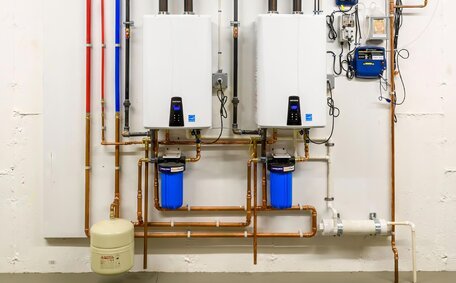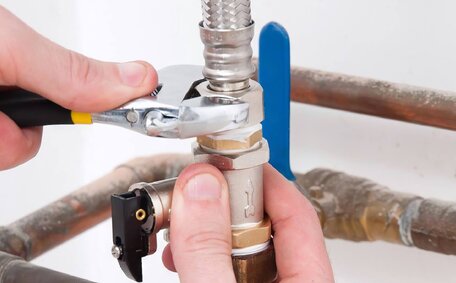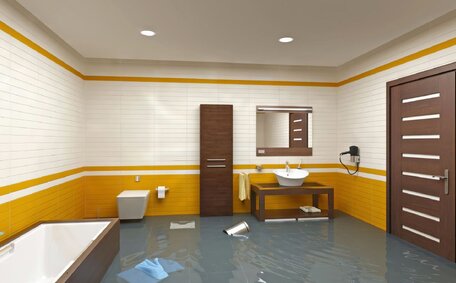Understanding Pilot Lights and How They Work
The pilot light is essential in gas water heaters for igniting the main burner that heats the water.
Different brands, including Rheem, Bradford White, and tankless models, have unique designs, but all perform the key function of igniting the water heater’s main burner. The pilot flame heats a thermocouple, which in turn signals the gas control valve through the regulator knob to initiate gas flow to the burner.
To safely relight the pilot light, follow precautionary measures such as checking for gas leaks and waiting five minutes before attempting ignition, ensuring the gas control knob is correctly positioned. If the pilot light frequently malfunctions, seek a licensed professional’s help, as continuous issues may signal damage, gas supply problems, or carbon monoxide risks.
When Pilot Lights Go Out
There are a few common reasons that can cause a pilot light to go out:
- Strong winds or drafts that physically blow out the flame
- Air bubbles or temporary interruptions in the gas supply lines
- Dirt or dust blocking the pilot light assembly
- The thermocouple, or pilot light, wont stay engaged to maintain the gas valve in an open state
The necessity to light the pilot light often stems from external factors or issues within the gas control system. Other potential concerns like damage or a malfunctioning part may arise, in particular if the pilot light gone out was not relit correctly.
Contact a licenced expert if you face recurring pilot light issues, as these often necessitate professional repair.
Check for gas leaks, ventilate the area if gas is present, and always
Safety First - Checking for Gas Leaks
Before attempting to relight the pilot light, prioritising safety is imperative. Shut off the gas and check for leaks by smelling around the pilot light area. Do not attempt to relight the pilot or turn the gas off using the control knob if you smell gas or suspect a leak.
Follow these precautions in your home:
- Ensure there is no gas by ventilating the area around your water heater, opening windows or doors before proceeding.
- Avoid using phones, switches, or any electrical devices near the gas leak area.
- Evacuate everyone from the vicinity of the gas leak
Ensure there is no lingering gas odour before attempting to relight the pilot light.
Be cautious when handling the pilot light area to avoid any flames or sparks near the water heater. Proper ventilation remains crucial. Should you encounter a gas aroma, swiftly reach out to your local provider or expert for issues with your gas pilot light.
Step-by-Step Guide to Relighting the Pilot Light
If you’re wondering 'how to safely relight the pilot light on my gas hot water system,' follow these key steps:
- Turn the gas knob, also known as the gas control knob down, placing it in the off position.
- Wait five minutes after shutting off the gas to allow any residual gas to disperse before trying to reignite the pilot.
- If your unit has an access panel, remove it to reach the pilot light and then wait an additional five minutes before continuing.
- Smell near the pilot area for any lingering gas odours before proceeding.
- Turn the control knob completely to the 'pilot’ position or to the indicated symbol.
- Press the ignition button, often a red button, and hold for about 30 seconds or until you see a steady pilot light.
- Continue holding the ignition button for 30-60 seconds until you observe flame activity, signaling that the thermocouple or flame sensor is heating.
- Release the ignitor button and ensure the water heater pilot light remains steadily lit for about a minute.
- To resume operation, turn the water knob to the 'on’ position.
Repeat the steps if the pilot light extinguishes mid-process, ensuring in step 7 that the thermocouple is sufficiently heated. Refer to the manual to relight your Rheem Stellar gas water units, as different brands may have slightly varied lighting procedures.
After activating the Rheem gas burner, check for a blue flame to confirm your system is functioning correctly. Allow 30-40 minutes for the water to reheat before use. If you notice a lack of hot water or detect a gas odour at any stage, switch everything off immediately and contact a professional experienced in gas fitting.
Troubleshooting Issues with Repeatedly Going Out
If your pilot light repeatedly goes out after successfully lighting it, there are a few common issues that may be the cause:
- Dirty thermocouple - Dust or residue on the thermocouple can prevent it from properly signalling the gas valve to remain open. Carefully clean the thermocouple with steel wool or sandpaper.
- Faulty thermocouple - If cleaning does not help, the thermocouple may be worn out or damaged. This part will need replacing.
- Obstructed pilot assembly - Make sure no dirt, spider webs or other debris is blocking the pilot light opening.
- Gas line pressure problems - Issues with your gas supply like air pockets or drops in pressure can also cause the pilot to go out. Contact your gas utility company if problems persist.
Commence the remedial process by sanitising the thermocouple and eliminating blockages around the pilot, or consider calling your local plumber to turn gas control valve issues. If the flame still repeatedly goes out, this indicates an underlying issue requiring professional repair to address risks like gas leaks or carbon monoxide buildup.
Should the hot water pilot light goes out repeatedly, reach out to a licenced plumber for assistance. Persistent outages put you at risk and require an expert diagnosis and fix. Do not keep relighting the pilot yourself if it continues going out.
When to Call a Professional
Homeowners often contemplate how to safely relight the pilot light of their hot water systems, abiding by the manufacturer’s guidelines. Recognising when to seek professional help for your gas hot water system issues is critical:
- You smell gas before or after attempting to relight the pilot. This could indicate a serious gas leak, which requires immediate professional attention for safe repair.
- The pilot light repeatedly goes out after successfully lighting it, despite troubleshooting efforts like cleaning the thermocouple or checking for obstructions.
- You’re unable to get the pilot light to stay lit after multiple relighting attempts. Persistent issues suggest a bigger underlying problem.
- You see dark soot buildup around the pilot assembly area or the burner flames appear yellow/orange instead of blue.
- The water is not heating up properly even after the pilot flame remains steadily lit.
- You lack the proper equipment, like a long fireplace lighter, or personal confidence in your abilities to relight the pilot safely.
In any of above situations, it’s best to call our team at Bella Vista Plumbing on 1300 349 338. Our licenced gas fitters have the expertise to inspect your system, diagnose issues, and repair any pilot light or gas control problems promptly. We serve customers across Bella Vista and wider Sydney.
For immediate assistance with your hot water pilot, get in touch with us by phone. Or you can book an appointment via email at [email protected]. Your safety comes first, so never hesitate to get professional assistance with a problematic pilot light or hot water system.
Preventative Maintenance to Avoid Future Issues
Being proactive with hot water system maintenance can prevent many pilot light problems from occurring. Follow this preventative care checklist:
- Inspect the pilot assembly and thermocouple monthly and brush or blow away any dust or debris
- Inspect the shutoff valve and ensure burner flames are blue, contacting us if you observe any orange/yellow flames
- Have a licenced technician perform an annual tune-up and safety inspection
- Replace the pilot assembly thermocouple every 2-3 years as a precaution
Scheduling regular preventative maintenance with our team is an effective strategy to avoid unexpected pilot light issues. Our qualified technicians will thoroughly assess your system to spot any underlying issues early.
Contact us to book an inspection or we also offer pilot light cleaning and troubleshooting appointments if youve had repeat issues. Take a proactive approach now to prevent problems down the track.
Call 1300 349 338 or email [email protected] to schedule maintenance.
Expected Hot Water Restore Timelines
Once you successfully reignite the pilot light, if it goes out again, you’ll need to relight it to achieve hot water within 30-40 minutes.
This timeframe is typical for a Rheem stellar gas heater or tankless water system to restore hot water capacity once the pilot is lit. The small flame first ignites the main burner, which in turn heats the water stored in the tank or heated on demand in a tankless system.
Allow 30-40 minutes after securing a stable pilot light and engaging the burner to enjoy your hot water heater system. You should perceive the pipes warming as you activate the hot water tap, with hot water forthcoming by the closure of this interval. The absence of hot water within this timeframe, despite a lit pilot light, indicates underlying issues such as:
- Faulty gas valves not opening properly
- Thermostat problems not aligning with the water temperature dial
- Sediment buildup inside the tank
- Issues with the heating elements or heat exchanger
Any of those would require a qualified gas fitter to inspect and repair, possibly dealing with power supply issues. Persistent hot water problems after relighting the pilot indicates professional attention is needed.
As licenced technicians, we have the expertise to accurately diagnose issues and get your hot water system working again promptly.






